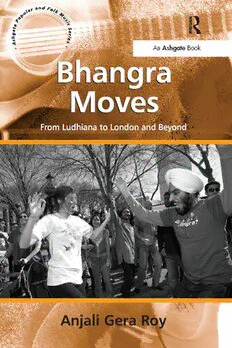
Bhangra Moves: From Ludhiana to London and Beyond PDF
Preview Bhangra Moves: From Ludhiana to London and Beyond
Bhangra Moves Bhangra Moves From Ludhiana to London and Beyond anjaLi gera roy Indian Institute of Technology, Kharagpur, India First published 2010 by Ashgate Publishing Published 2016 by Routledge 2 Park Square, Milton Park, Abingdon, Oxon OX14 4RN 711 Third Avenue, New York, NY 10017, USA Routledge is an imprint of the Taylor & Francis Group, an informa business Copyright © 2010 anjali gera roy anjali gera roy has asserted her right under the Copyright, Designs and Patents act, 1988, to be identified as the author of this work. All rights reserved. No part of this book may be reprinted or reproduced or utilised in any form or by any electronic, mechanical, or other means, now known or hereafterinvented, including photocopying and recording, or in any information storage orretrieval system, without permission in writing from the publishers. Notice: Product or corporate names may be trademarks or registered trademarks, and are used only for identification and explanation without intent to infringe. British Library Cataloguing in Publication Data roy, anjali gera. Bhangra moves: from Ludhiana to London and beyond. – (Ashgate popular and folk music series) 1. Bhangra (Music) – History and criticism. 2. Popular music – India – Punjab – History and criticism. 3. south asians – Foreign countries – Music. 4. Popular music – indic influences. i. Title ii. series 781.6'291421-dc22 Library of Congress Control Number: 2010920890 ISBN 9780754658238 (hbk) Contents List of Figures and Tables vii General Editor’s Preface ix Acknowledgements xi 1 Flows across the Chenab 1 2 no Mixing Please! We are indian 29 3 Mann Panjab De: Fabricating authenticity 49 4 Naqqal, Mimicry and the Signifying Monkey 79 5 global Bazaar, Local Peddlers 103 6 Desi Networks 129 7 Cool guys, Desi Boyz and Panjabi Munde Dance the Bhangra 153 8 Performing the Panjabi Body 175 9 Bhangra nation 199 10 Who Speaks for the Jat?:vernacular Cosmopolitanisms 223 Appendix 1 Music Survey Conducted Between 2000 and 2006 239 Appendix 2 Excerpt from Marketing Study on Panjabi Music Conducted by Darshpreet Mann 243 Appendix 3 Glossary 253 Appendix 4 Incorrect and Correct Transcriptions of “Mundian To Bach Ke” Lyrics 257 Bibliography 261 Index 283 List of Figures and Tables Figures 1.1 Panjabi male dancers. reproduced by permission of Manjit singh 20 1.2 Panjabi female dancers. reproduced by permission of Manjit singh 20 3.1a Mann Panjab De – Pammi Bai. reproduced by permission of Pammi Bai 51 3.1b Mann Panjab De – gurdas Mann. reproduced from www.gurdasmaan.com by permission of gurdas Mann 51 3.1c Mann Panjab De – Malkit Singh. reproduced by permission of Malkit Singh 52 3.2 gurdas Mann. reproduced from www.gurdasmaan.com by permission of gurdas Mann 62 3.3 Malkit Singh. Reproduced by permission of Malkit Singh 69 3.4 Pammi Bai. reproduced by permission of Pammi Bai 73 4.1 Daler Mehndi. reproduced by permission of Daler Mehndi 88 5.1 Cycle of music production. reproduced from Mann 2000, with permission 113 5.2 Perceptual map of the Indian music market. Reproduced from jain 2000, with permission 121 8.1 Lohri fire. Reproduced by permission of Manjit Singh 191 8.2 The Panjabi clap. reproduced by permission of Manjit singh 192 9.1 The new generation – h-Dhami. reproduced by permission of rishi rich Productions 217 Tables 5.1 Mass music and future scope. reproduced from jain 2000, with permission 117 9.1 Bhangra singers. reproduced from www.punjabonline.com (“Bhangra Artists” 2004) 216 general editor’s Preface The upheaval that occurred in musicology during the last two decades of the twentieth century has created a new urgency for the study of popular music alongside the development of new critical and theoretical models. a relativistic outlook has replaced the universal perspective of modernism (the international ambitions of the 12-note style); the grand narrative of the evolution and dissolution of tonality has been challenged, and emphasis has shifted to cultural context, reception and subject position. Together, these have conspired to eat away at the status of canonical composers and categories of high and low in music. a need has arisen, also, to recognize and address the emergence of crossovers, mixed and new genres, to engage in debates concerning the vexed problem of what constitutes authenticity in music and to offer a critique of musical practice as the product of free, individual expression. Popular musicology is now a vital and exciting area of scholarship, and the Ashgate Popular and Folk Music Series presents some of the best research in the field. authors are concerned with locating musical practices, values and meanings in cultural context, and draw upon methodologies and theories developed in cultural studies, semiotics, poststructuralism, psychology and sociology. The series focuses on popular musics of the twentieth and twenty-first centuries. It is designed to embrace the world’s popular musics from acid jazz to Zydeco, whether high tech or low tech, commercial or non-commercial, contemporary or traditional. Professor Derek B. Scott Professor of Critical Musicology University of Leeds
